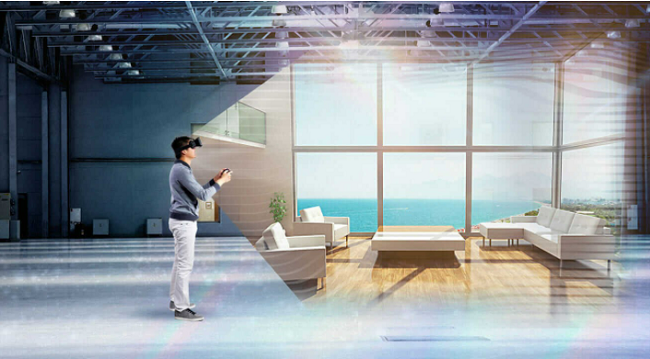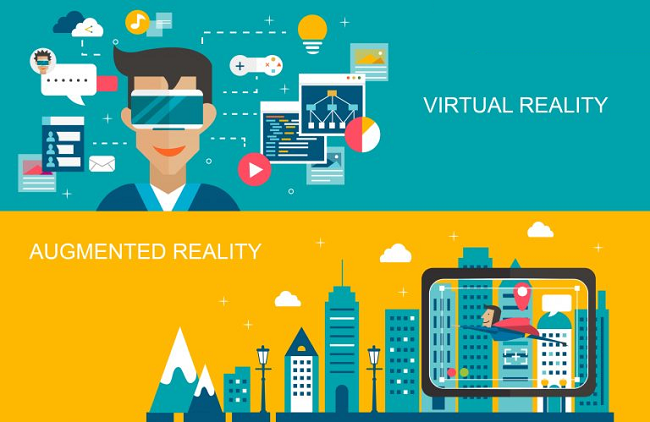You’re walking through a beautiful house, loving the breathtaking views from the living-room windows, the inch-perfect kitchen, and the vintage artwork on the wall. The modish wall lights cast a soft glow, and the furniture just leaves you in awe.
After the tour, you take off your VR goggles and continue your meeting with the designer.
Our world is starting to get more digitized day by day. Most of the appliances we have are starting to get upgraded and called “smart” because they’re now automated. Technology just keeps advancing and making our lives better.

It’s not surprising to see that both virtual reality (VR) and augmented reality (AR) is now being adopted by industries. Out of these industries, the design and architecture industry are some of the industries that are finding it very useful to integrate AR and VR in their workstream.
And why not? It is a match made in heaven.
A designer’s imagination and the technology to make it come to life bring a magical experience for clients. Back then, the designs were limited to drawings on paper and models on computers. Now, clients can see the design right before their eyes.
So how are designers using AR and VR in their designing process? That secret lies in the definitions themselves. Let’s first check those out.
The Difference Between AR and VR
AR and VR can be confusing if you’re encountering them for the first time. Let’s take a moment to discuss the difference between AR and VR first. This will help us understand how both excel at their own strengths when applied to the design and architecture industry.
Augmented reality (AR) is an experience where designers can enhance the physical spaces with computer-generated input. In short, architects can digitally interact with their projects by overlapping the digital model over a physical space.
It simply creates a 3D version of the project and places it in our physical reality. This lets designers visualize the proposed space long before its development. This provides a better understanding of the project outcome, therefore, improving the design as the digital content responds to changes in real-time.

Whereas, Virtual reality is the use of advanced computer technology to create a simulated environment. It is an experience where users can immerse themselves in a virtual environment with the use of both software and hardware.
For example, one experience could be a walk through a virtual museum where users move freely and interact with predetermined tasks.
Virtual reality makes meetings and walkthroughs with clients in dream homes possible. Virtual reality is an amazing present and an exciting future.
How are AR and VR Beneficial in the Designing Process?
Both technologies offer exceptional potential for the advancement of designing processes and opportunities in the architecture field. How are designers taking advantage of this?
Let’s find out!
Enhance Interactions with Clients
Communication is the key to providing the best experience for clients. Often, designers and clients are not on the same page in their expectations. Viewing and experiencing the product designs in VR can reduce potential friction and allow for smoother communication.
Clients can point to any areas of misunderstanding in the plans. In response, the designers can make suggestions for improvements to address the concerns of the client.
This process saves a lot of time. This process would have taken months, sometimes years, to build and agree on a design. With VR running the show, it can now be achieved within a few hours.
And not only is it an effective strategy, but it’s also engaging for both clients and designers to work in a collaborative visual environment. It is an emotional experience for clients to see their future homes, offices, and other products. There can be a lot on the line for them so seeing progress can be worth so much.
Example: The designer is working on a building project. He isn’t sure what the client has in mind for some extra space next to a meeting room in the structure. According to the specifications, this extra space wasn’t part of the plan. The client comes in to check out the design with VR and they agree to include a small storage unit.
Streamline Existing Processes
AR and VR are not about removing the traditional design processes but about supplementing the existing processes for designers and streamlining them. This way, designers can quickly experience their work to get a sense and feel of the space before construction begins. So, all the imaginative pencil drawings are still in play but with a digital upgrade.
By incorporating AR, designers can even visualize their designs and drawings in the same location in which they will stand. This on-site advantage will improve data estimations for more timely implementation of improvements in design or client feedback. Designers and clients can avoid late and costly adjustments to plans.
Example: An experienced designer is working on a design of a ceiling structure that is complex and difficult to imagine. But as soon as the designer gets into AR, she can see and feel how the amount of space is ample for the specifications and can modify the drawings and improve the design.
Improves Design
No one is a fan of ongoing revisions of product designs. VR proves to be a lifesaver here as it comes with intuitive ways to produce new things. The traditional 3D designs or models of buildings and spaces are nothing new. It might not even fully embody the client’s vision, hence the need for time-consuming revisions.
Now, with AR and VR, the clients and architects can stand in a room and witness the future product in its actual setting.
Designers can precisely match the quality in rendered models with the actual product quality without multiple revisions.
VR provides an immersive creation and a more accurate depiction of 3D models. It allows the design engineers to see the product from different angles to refine and improve them. It lowers costs and helps meet deadlines for faster delivery to satisfied clients.
Example: A creative designer working on a museum architecture project has revised the designs and drawings several times but couldn’t get near the client’s expectations. He tries VR to check out the entire 3D model in a more refined and realistic way. Finally, by visualizing the exact dimensions of the museum, the architect could roll out a design that meets the client’s standards.
The Bottom Line
Technology has transformed design in ways one could never have imagined. The architecture and design industries have an excellent opportunity to continue to grow through ongoing innovations.
As AR and VR tools become more precise, the use of these in design will prove increasingly significant.
Companies using these tools to optimize their design processes are offering an ultimate experience to their clients. This sets them apart as leaders in the design industry.
If any designer is looking to get started with AR and VR, now is the perfect time to give wings to their ambition.
How familiar are you with AR and VR in the design process? What are your thoughts on the ideas around incorporating these spectacular technologies into practice?

